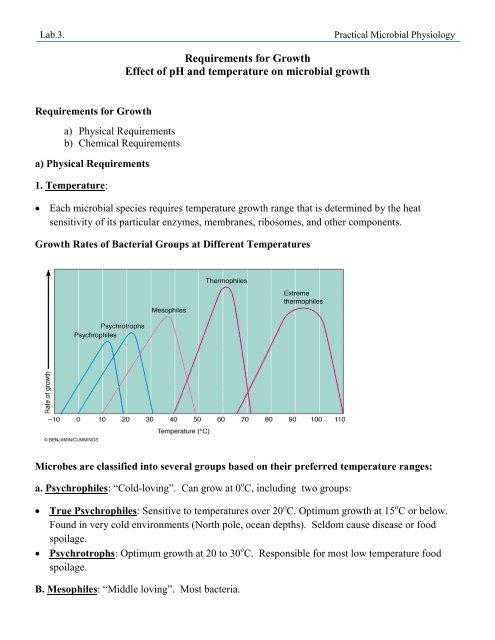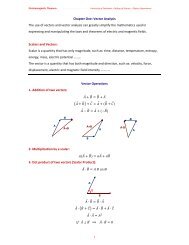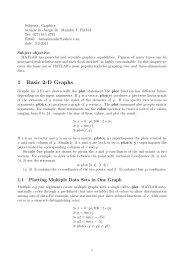Requirements for Growth Effect of pH and temperature on microbial ...
Requirements for Growth Effect of pH and temperature on microbial ...
Requirements for Growth Effect of pH and temperature on microbial ...
Create successful ePaper yourself
Turn your PDF publications into a flip-book with our unique Google optimized e-Paper software.
Lab.3.<br />
Practical Microbial Physiology<br />
<str<strong>on</strong>g>Requirements</str<strong>on</strong>g> <str<strong>on</strong>g>for</str<strong>on</strong>g> <str<strong>on</strong>g>Growth</str<strong>on</strong>g><br />
<str<strong>on</strong>g>Effect</str<strong>on</strong>g> <str<strong>on</strong>g>of</str<strong>on</strong>g> <str<strong>on</strong>g>pH</str<strong>on</strong>g> <str<strong>on</strong>g>and</str<strong>on</strong>g> <str<strong>on</strong>g>temperature</str<strong>on</strong>g> <strong>on</strong> <strong>microbial</strong> growth<br />
<str<strong>on</strong>g>Requirements</str<strong>on</strong>g> <str<strong>on</strong>g>for</str<strong>on</strong>g> <str<strong>on</strong>g>Growth</str<strong>on</strong>g><br />
a) Physical <str<strong>on</strong>g>Requirements</str<strong>on</strong>g><br />
b) Chemical <str<strong>on</strong>g>Requirements</str<strong>on</strong>g><br />
a) Physical <str<strong>on</strong>g>Requirements</str<strong>on</strong>g><br />
1. Temperature:<br />
Each <strong>microbial</strong> species requires <str<strong>on</strong>g>temperature</str<strong>on</strong>g> growth range that is determined by the heat<br />
sensitivity <str<strong>on</strong>g>of</str<strong>on</strong>g> its particular enzymes, membranes, ribosomes, <str<strong>on</strong>g>and</str<strong>on</strong>g> other comp<strong>on</strong>ents.<br />
<str<strong>on</strong>g>Growth</str<strong>on</strong>g> Rates <str<strong>on</strong>g>of</str<strong>on</strong>g> Bacterial Groups at Different Temperatures<br />
Microbes are classified into several groups based <strong>on</strong> their preferred <str<strong>on</strong>g>temperature</str<strong>on</strong>g> ranges:<br />
a. Psychrophiles: “Cold-loving”. Can grow at 0 o C, including two groups:<br />
True Psychrophiles: Sensitive to <str<strong>on</strong>g>temperature</str<strong>on</strong>g>s over 20 o C. Optimum growth at 15 o C or below.<br />
Found in very cold envir<strong>on</strong>ments (North pole, ocean depths). Seldom cause disease or food<br />
spoilage.<br />
Psychrotrophs: Optimum growth at 20 to 30 o C. Resp<strong>on</strong>sible <str<strong>on</strong>g>for</str<strong>on</strong>g> most low <str<strong>on</strong>g>temperature</str<strong>on</strong>g> food<br />
spoilage.<br />
B. Mesophiles: “Middle loving”. Most bacteria.
Include most pathogens <str<strong>on</strong>g>and</str<strong>on</strong>g> comm<strong>on</strong> spoilage organisms.<br />
Best growth between 25 to 40 o C.<br />
Optimum <str<strong>on</strong>g>temperature</str<strong>on</strong>g> comm<strong>on</strong>ly 37 o C.<br />
<br />
Many have adapted to live in the bodies <str<strong>on</strong>g>of</str<strong>on</strong>g> animals.<br />
C. Thermophiles: “Heat loving”.<br />
Optimum growth between 50 to 60 o C.<br />
Many cannot grow below 45 o C.<br />
<br />
<br />
Adapted to live in sunlit soil <str<strong>on</strong>g>and</str<strong>on</strong>g> hot springs.<br />
Some thermophiles <str<strong>on</strong>g>for</str<strong>on</strong>g>m heat resistant endospores.<br />
Extreme Thermophiles (Hyperthermophiles): Optimum growth at 80 o C or higher.<br />
Archaebacteria. Most live in volcanic <str<strong>on</strong>g>and</str<strong>on</strong>g> ocean vents.<br />
Organism Minimum Optimum Maximum<br />
Bacillus cereus 5 28 - 40 55<br />
Campylobacter spp. 32 42 - 45 45<br />
Clostridium botulinum 10 - 12 30 - 40 50<br />
Clostridium perfringens 12 43 - 47 50<br />
Enterotoxigenic Escherichia coli 7 35 - 40 46<br />
Listeria m<strong>on</strong>ocytogenes 0 30 - 37 45<br />
Salm<strong>on</strong>ella spp. 5 35 - 37 45 - 47<br />
Staphylococcus aureus 7 35 - 40 48<br />
Shigella spp. 7 37 45 - 47<br />
Vibrio cholerae 10 37 43<br />
Vibrio parahaemolyticus 5 37 43<br />
Vibrio vulnificus 8 37 43<br />
Yersinia enterocolitica -1 28 - 30 42<br />
2. <str<strong>on</strong>g>pH</str<strong>on</strong>g>:<br />
<str<strong>on</strong>g>pH</str<strong>on</strong>g> dramatically affects bacterial growth, this is because that <str<strong>on</strong>g>pH</str<strong>on</strong>g> affects the activity <str<strong>on</strong>g>of</str<strong>on</strong>g> enzymes<br />
those that are involved in biosynthesis <str<strong>on</strong>g>and</str<strong>on</strong>g> growth.<br />
Each <strong>microbial</strong> species possesses a definite <str<strong>on</strong>g>pH</str<strong>on</strong>g> growth range <str<strong>on</strong>g>and</str<strong>on</strong>g> a distinct <str<strong>on</strong>g>pH</str<strong>on</strong>g> growth<br />
optimum.
Most bacteria prefer neutral <str<strong>on</strong>g>pH</str<strong>on</strong>g> (6.5-7.5).<br />
Molds <str<strong>on</strong>g>and</str<strong>on</strong>g> yeast grow in wider <str<strong>on</strong>g>pH</str<strong>on</strong>g> range, but prefer <str<strong>on</strong>g>pH</str<strong>on</strong>g> between 5 <str<strong>on</strong>g>and</str<strong>on</strong>g> 6.<br />
Organisms can be classified as:<br />
A. Acidophiles: “Acid loving”.<br />
Grow at very low <str<strong>on</strong>g>pH</str<strong>on</strong>g> (0.1 to 5.4)<br />
<br />
Lactobacillus produces lactic acid, tolerates mild acidity.<br />
B. Neutrophiles:<br />
Grow at <str<strong>on</strong>g>pH</str<strong>on</strong>g> 5.4 to 8.5.<br />
<br />
Includes most human pathogens.<br />
C. Alkaliphiles: “Alkali loving”.<br />
<br />
Grow at alkaline or high <str<strong>on</strong>g>pH</str<strong>on</strong>g> (7 to 12 or higher)<br />
Vibrio cholerae <str<strong>on</strong>g>and</str<strong>on</strong>g> Alkaligenes faecalis optimal <str<strong>on</strong>g>pH</str<strong>on</strong>g> 9.<br />
Soil bacterium Agrobacterium grows at <str<strong>on</strong>g>pH</str<strong>on</strong>g> 12.<br />
Microorganism Minimum Optimum Maximum<br />
Clostridium perfringens 5.5 - 5.8 7.2 8.0 - 9.0<br />
Vibrio vulnificus 5.0 7.8 10.2<br />
Bacillus cereus 4.9 6.0 -7.0 8.8<br />
Campylobacter spp. 4.9 6.5 - 7.5 9.0<br />
Shigella spp. 4.9 9.3<br />
Vibrio parahaemolyticus 4.8 7.8 - 8.6 11.0<br />
Clostridium botulinum 4.6 8.5<br />
Staphylococcus aureus 4.0 6.0 - 7.0 10.0<br />
Enterohemorrhagic Escherichia coli 4.4 6.0 - 7.0 9.0<br />
Listeria m<strong>on</strong>ocytogenes 4.39 7.0 9.4<br />
Salm<strong>on</strong>ella spp. 4.2 1 7.0 - 7.5 9.5<br />
Yersinia enterocolitica 4.2 7.2 9.6
















